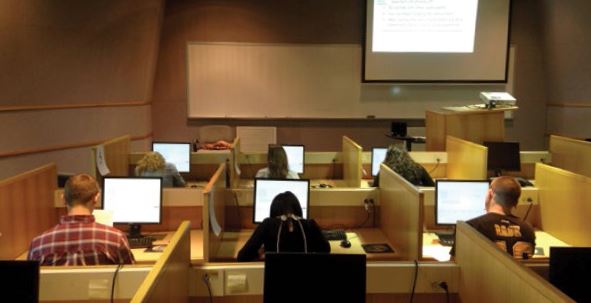Will better information lead to better choices?

Study subjects consider information and make decisions as part of a research experiment at the University of Rhode Island.
Will better information lead to better choices?
Researchers study influences on decisions that impact water quality
By Amy Dunkle
The hydrological and geological data being collected by high tech sensors in three Rhode Island watersheds will do a lot more than track what flows through our water.
The information also will be plugged into economic models that can test how the better monitoring influences people’s actions; whether people will make better choices if given better information.
“The social science role is to try to understand how better information about water quality affects people’s decisions,” explained Dr. Emi Uchida, Associate Professor, Environmental and Natural Resource Economics, who is leading the University of Rhode Island’s economics team for the Rhode Island NSF EPSCoR watershed project.
Here in the Ocean State, Dr. Uchida is working with URI faculty Dr. Todd Guilfoos, Assistant Professor, Environmental and Natural Resource Economics; and Dr. Simona Trandafir, Visiting Assistant Professor, Environmental and Transportation Economics; and RI NSF EPSCoR graduate fellow Haoran Miao.
The group members also collaborate with their peers in Vermont and Delaware as part of the three-state North East Water Resources Network (NEWRnet), conducting experiments to gauge whether and how the information sways behavior.
What incentives work?
For example, this spring, the economists experimented how better monitoring of water quality affected business owners’ decisions about how much to produce when more production meant more contaminants and a higher penalty.
Non-point source pollution — when contaminants from many sources move with the soil through the watershed, untraced — complicates the situation. If the regulator cannot trace whether your business is responsible for the pollution, what incentives might encourage you to employ environmentally friendly, possibly more expensive, practices?
This base level of studying individual behavior, how specific information causes a person to act in a certain way, is being tested using methods in experimental economics. Student subjects involved in the study played for real money; the amount they took home depended on how well they performed, providing critical insight into how different frequency and intensity of water quality monitoring dictate behavior.
One of the challenges, however, stems from the fact that there are yet few applications of such experiments in the realm of water quality, so researchers faced the task of designing the experiment and integrating economic decisions with an appropriate hydrological model that can simulate their impact on water quality, explained Dr. Uchida: “How people react to better information about the environment is new territory.”
That they are treading on some unfamiliar ground is not lost on the researchers. Dr. Uchida said the experiments could apply to other settings, such as climate change, where gauging the impact of information on behavior could yield valuable data.
The decision-making process
The study gives subjects a role and specific information to act on — each operates a parcel of land alongside a river, and they get to make decisions about how much they will produce.
They also receive information about the impact of their production levels and details about water quality monitoring. Water quality monitoring is done at one or more points along the river at different frequencies. Will they opt to produce less if they know that the water quality is being monitored at a higher frequency or at more locations? What if they can get a subsidy to offset revenue loss?
“We start under a setting where there is no monitoring and no tax or subsidy,” Dr. Uchida said. “Then, we change how the water quality is monitored and also introduce a tax or subsidy depending on the level of pollution. For example, in one setting water quality may be monitored at one point in the river, once a period. Then in another setting, the water quality is monitored four times per period. That’s going to change the incentives — they will have a higher chance of getting detected. How will this better monitoring affect their business decisions?”
Researchers also can add more factors into the equation such as employing a second sensor that will monitor businesses further upstream and penalize the entire group if the total concentration level increases.
Observing strategic behavior
In the coming year, the study transitions to what is known as agent based modeling (ABM), where researchers can simulate how the reactions of different stakeholders to water quality affect each other’s behavior.
Dr. Uchida said one of the novelties of the project is that the social science team includes specialists in both experimental economics and ABM. In contrast to experimental economics that uses human subjects to observe real strategic behavior, ABMs are large scale simulations with different types of agents that are programmed with specific strategies, learning, or decision algorithms. This will allow the team to scale up the insights from the laboratory experiments, scaling up what they find in the experimental model in the ABM.
“We might be able to say, if we change the extent of water quality monitoring, not only how would a landowner respond, but also how that response affects other landowners,” Dr. Uchida said. “What happens if we allow business owners to communicate with each other? What happens if downstream businesses see that upstream businesses have cut their production? Will they come to a better decision that might result in less pollution?”
The team hopes to take the economic models beyond the test subjects to real stakeholders who make the decisions that impact water quality — landowners, farmers, business owners, municipal officials — and learn how to improve watershed management, which will lead to better water quality.
